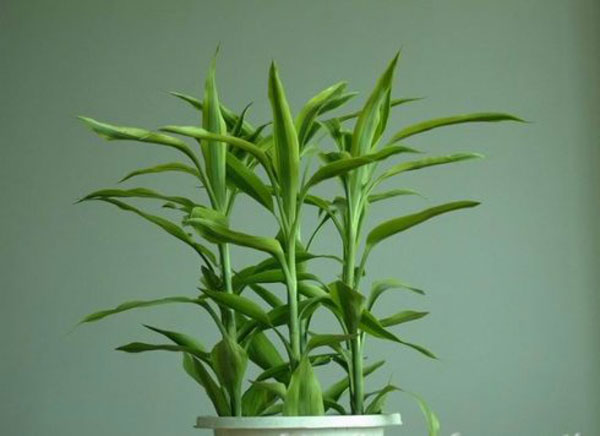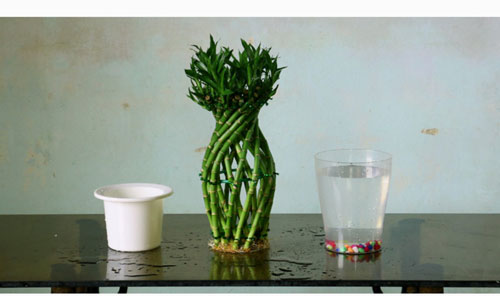Lucky Bamboo (Dracaena Sanderiana) Grow & Care Guide
Written by Iris
Dec 28 2022
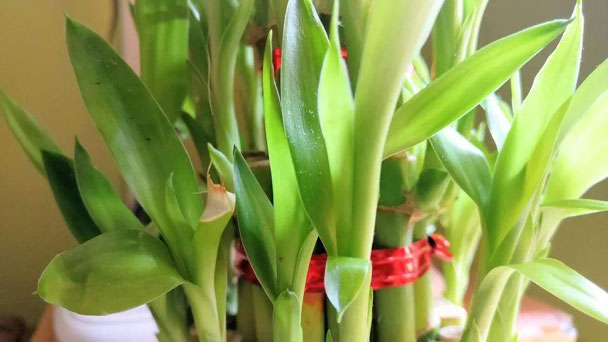
Lucky bamboo (Dracaena Sanderiana) is a commonly cultivated houseplant that can be grown hydroponically or in soil. While its stalks resemble those of a true bamboo plant, the lucky bamboo plant is actually a part of the Asparagaceae family. Lucky bamboo has deep roots in Feng Shui—an ancient Chinese philosophy that dates back to the ninth-century BC—and is thus traditionally given as a gift to promote good luck, good fortune, love, health, and growth.
This plant actually grows better without direct sun, so choose a place with bright, indirect light for best results. If you see brown patches on the leaves, move your lucky bamboo to a shadier spot.1
Planting directly in distilled water creates the best growing conditions for lucky bamboo, and potting in soil makes it more susceptible to drying out. To keep your plant healthy in a soil planter, ensure the container has holes on the bottom (use a plant tray to protect household surfaces), and plant with a well-draining potting mix.
Hydroponic lucky bamboo plants look fabulous in clear glass containers. Transparent glass containers enable you to monitor the health of your plant’s roots. These containers also show off the decorative pebbles or glass pieces that are used to propagate the plant’s roots. The container should be at least 2 inches bigger than the plant it holds. Containers may be any shape. (Read Next: How Big Will Lucky Bamboo Grow?)
If you’re propagating your plant in soil, opt for a ceramic or terra cotta container. The container should have a diameter that is a few inches larger than that of your plant arrangement. It should also feature plenty of drainage holes. Place a small tray or saucer under the container to avoid compromising your home or furniture.
Use twist ties, pieces of ribbon, or cloth shards to secure multiple stalks together. Pour distilled or purified water into the container to cover the roots. A few inches of water should be sufficient. (Read Next: How To Repot Lucky Bamboo)
When you're finished, place the container in a warm, low-light location. Monitor your plant daily to ensure that it is healthy and thriving. Top the container off with distilled water to ensure that it maintains a healthy level.
Place a shallow layer of this Lucky Bamboo soil mixture in the base of your container. Place the roots of your lucky bamboo plant on top of this soil bed. Gently, fill in the area around the roots. A few inches of soil coverage should be enough to support the stalks. You can always trim off and propagate the upper portions of the stems when your plants become too top-heavy.
Young lucky bamboos stalk fair well in hydroponic setups. However, mature plants thrive more in soil. As such, you may wish to switch up your plant's surroundings as it ages. (Read more about trimming Lucky Bamboo.)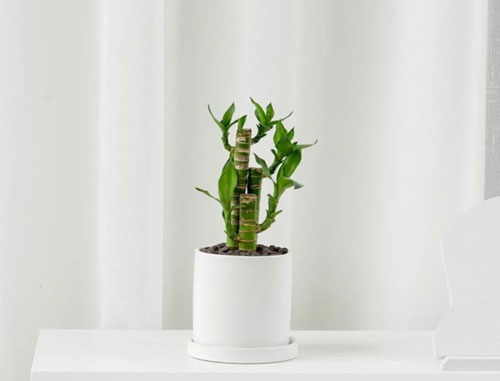
Algae can form in the water, so try to clean out the container and change the water regularly (about once a week). Tap water is okay for the bamboo plant to drink, as long as chlorine levels are low. To be safe, leave tap water out overnight so the chlorine can evaporate before you use it to water your lucky bamboo.
ProTip: If you have high levels of fluoride in your tap water, we recommend using filtered water, such as bottled water. Fluoride will not evaporate and is toxic to plants like lucky bamboo.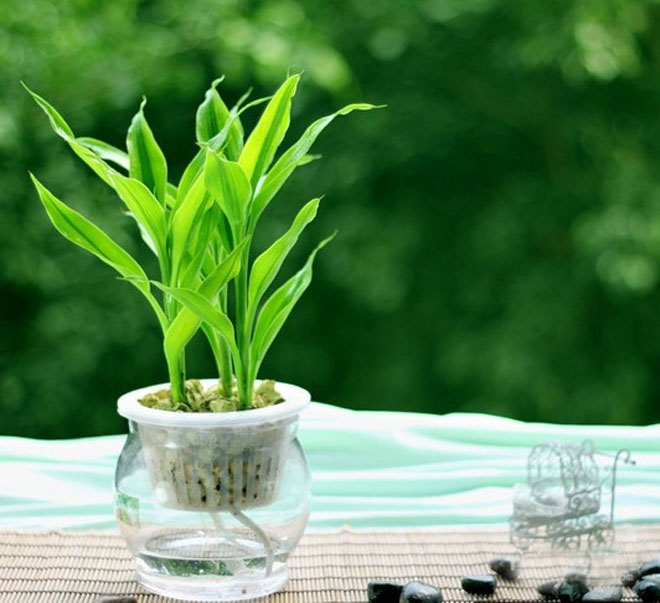
Read Next:
Why Is My Lucky Bamboo Turning Yellow
It is best to raise 2 or 5 lucky bamboos in pot culture. According to Feng Shui, this culture can expand the power of the earth, and the rich bamboo is not easy to die. If we raise 5 roots, we can choose the method of 4 long and 1 short to promote our study and career.
Let's take a look at the Feng Shui highlights of lucky bamboo. Lucky bamboo can urge wealth by putting it in the wealth position at home. Generally, the position on the diagonal of the door is the wealth position. However, the wealth should not be too heavy, so the quantity of lucky bamboo or the weight of the water should be appropriate.
In addition to the location of lucky bamboo on Feng Shui, we can also put lucky bamboo above the refrigerator, kitchen, bathroom, next to the column, stairwell, etc. at home, which can dissolve the evil spirit.
Read Next:
How To Save My Unhealthy Lucky Bamboo
Lucky Bamboo Quick InfoWhere to Grow Lucky BambooHow to Grow Lucky BambooHow to Grow Lucky Bamboo in WaterHow to Grow Lucky Bamboo in SoilHow to care for Lucky BambooLucky Bamboo Light CareLucky Bamboo Soil CareLucky Bamboo WateringLucky Bamboo Temperature & Humidity CareLucky Bamboo FertilizerLucky Bamboo Pests & DiseasesLucky Bamboo Care FAQsWhy does a bamboo plant turn yellow?How do I bring my bamboo plant back to life?How long do bamboo plants live?How many bamboo stalks are needed for good luck?Lucky Bamboo Feng Shui
Lucky Bamboo Quick Info
| Botanical/Scientific Name | Dracaena Sanderiana |
| Common Name | Dracaena Braunii, Lucky Bamboo |
| Uses | Decoration, Aquariums, Feng Shui |
| Origin | Southeast Asia |
| Light Care | Tolerate light shade and indirect sunlight |
| Soil Care | Well-drained, rich potting soil |
| Temperature Care | 65–95°F (18–35°C) |
| Humidity Care | High humidity above 50% |
| Watering | Water about once a week |
| Pruning Care | Pruning shears, cut back any shoots |
| Fertilizer Care | Doesn't require much fertilizer |
| Propagation | Taking cuttings |
| Toxic | Isn't poisonous to humans |
| Flower Color | White |
Where to Grow Lucky Bamboo
Part of the reason that Lucky Bamboo is such a ubiquitous indoor plant is that it needs very little light to thrive, making it a great option for low-light spaces like offices and hallways. Pick a space for your lucky bamboo in which temperatures don't drop below 65 degrees at night, and avoid drafty areas.This plant actually grows better without direct sun, so choose a place with bright, indirect light for best results. If you see brown patches on the leaves, move your lucky bamboo to a shadier spot.1
Planting directly in distilled water creates the best growing conditions for lucky bamboo, and potting in soil makes it more susceptible to drying out. To keep your plant healthy in a soil planter, ensure the container has holes on the bottom (use a plant tray to protect household surfaces), and plant with a well-draining potting mix.
Hydroponic lucky bamboo plants look fabulous in clear glass containers. Transparent glass containers enable you to monitor the health of your plant’s roots. These containers also show off the decorative pebbles or glass pieces that are used to propagate the plant’s roots. The container should be at least 2 inches bigger than the plant it holds. Containers may be any shape. (Read Next: How Big Will Lucky Bamboo Grow?)
If you’re propagating your plant in soil, opt for a ceramic or terra cotta container. The container should have a diameter that is a few inches larger than that of your plant arrangement. It should also feature plenty of drainage holes. Place a small tray or saucer under the container to avoid compromising your home or furniture.
How to Grow Lucky Bamboo
How to Grow Lucky Bamboo in Water
You will need a small container and some sort of supportive material, such as pebbles, rocks, glass gems, or polymer beads. Before planting, wash the container and fillers in warm water to remove any impurities. Repot the Lucky Bamboo stalks in a container and then sprinkle the supportive material around the root networks.Use twist ties, pieces of ribbon, or cloth shards to secure multiple stalks together. Pour distilled or purified water into the container to cover the roots. A few inches of water should be sufficient. (Read Next: How To Repot Lucky Bamboo)
When you're finished, place the container in a warm, low-light location. Monitor your plant daily to ensure that it is healthy and thriving. Top the container off with distilled water to ensure that it maintains a healthy level.
How to Grow Lucky Bamboo in Soil
Since wild lucky bamboo grows in soil, it makes sense that many cultivators go this route. Choose a small terra cotta or porcelain pot with plenty of drainage holes. Prepare your soil by adding drainage-improving amendments, such as peat, sand, and pebbles.Place a shallow layer of this Lucky Bamboo soil mixture in the base of your container. Place the roots of your lucky bamboo plant on top of this soil bed. Gently, fill in the area around the roots. A few inches of soil coverage should be enough to support the stalks. You can always trim off and propagate the upper portions of the stems when your plants become too top-heavy.
Young lucky bamboos stalk fair well in hydroponic setups. However, mature plants thrive more in soil. As such, you may wish to switch up your plant's surroundings as it ages. (Read more about trimming Lucky Bamboo.)

How to care for Lucky Bamboo
Lucky Bamboo Light Care
Lucky bamboo requires moderate or indirect sunlight. Direct sunlight will scorch the leaves, so avoid placing your plant in front of a bright window. Scorched leaves look like how they sound: The edges of the leaves will have a brown tinge to them almost like they were burned by fire. If your leaves look a little scorched, move your bamboo to an area with less light.Lucky Bamboo Soil Care
Lucky bamboo can be grown in well-drained, rich potting soil. The soil should be kept moist, but not soaking. Additionally, it can thrive well when housed in pebbles or simply a vase filled with water, as long as it has at least an inch of standing water at all times.Lucky Bamboo Watering
If growing your plant in soil, make sure it’s kept slightly damp. Don’t let the soil get too dry and don't overwater since that can lead to root rot. Bamboo does not need much water to survive, but it can be grown in water as well. If you choose to grow your bamboo in water, make sure the roots always stay covered with water. Replenish your lucky bamboo with fresh water every seven to 10 days to keep it happy and healthy. (Read more about saving Lucky Bamboo root rot.)Algae can form in the water, so try to clean out the container and change the water regularly (about once a week). Tap water is okay for the bamboo plant to drink, as long as chlorine levels are low. To be safe, leave tap water out overnight so the chlorine can evaporate before you use it to water your lucky bamboo.
ProTip: If you have high levels of fluoride in your tap water, we recommend using filtered water, such as bottled water. Fluoride will not evaporate and is toxic to plants like lucky bamboo.
Lucky Bamboo Temperature & Humidity Care
Lucky bamboo thrives in temperatures anywhere from 65–95°F (18–35°C), so it makes a great office or house plant. During colder months, be wary about leaving your plant near windows or other places with a cold draft.Lucky Bamboo Fertilizer
A single drop of liquid fertilizer each month is plenty for most lucky bamboo arrangements, and plants grown in water will only need to be fed every other month or so, using a very weak liquid fertilizer. Alternatively, specialty lucky bamboo fertilizers are available. (Read more about Lucky Bamboo Fertilizer.)Lucky Bamboo Pests & Diseases
Some common pests that affect lucky bamboo include mealybugs, mites and fungal infections. If you notice grey fuzz on your plant it could be a fungal infection, so remove the infected growth, keep the stalk and leaves dry, and increase air circulation. Mealybugs are small white insects that should be removed manually and with rubbing alcohol. Although mites (presented as white webbing or fuzz) don’t typically affect lucky bamboo, they can be caught by other household plants. They need to be eradicated with water and dish detergent — see plant disease treatments for more detail.
Lucky Bamboo Care FAQs
Why does a bamboo plant turn yellow?
A lucky bamboo plant can turn yellow for a couple of reasons. These include too much fertilizer, too much chlorine or fluoride in the water, or too much sun.Read Next:
Why Is My Lucky Bamboo Turning Yellow
How do I bring my bamboo plant back to life?
This depends on what your plant care routine is. If you have a yellow lucky bamboo plant, adjust accordingly by stopping fertilization, switching to filtered water or moving your plant to a place with less light. If your lucky bamboo has been infiltrated by pests or fungi, remove the infected area and use a (natural) pesticide, soap or rubbing alcohol depending on the plant’s ailment.How long do bamboo plants live?
Lucky Bamboo grown in water can live about one to two years. For a longer lifespan transfer your bamboo to soil where it can live for several years. It may shed leaves, but as long as you care for it well, it will keep replenishing and growing new leaves.How many bamboo stalks are needed for good luck?
Lucky bamboo plants with one to nine stalks are all acceptable for good luck and well wishes (except four stalks which is bad luck and should be avoided).Lucky Bamboo Feng Shui
If we propagate lucky bamboo in water, we'd better have one. Raising one can not only attract money but also ensure that the water will not be absorbed by other lucky bamboos, which means a grand plan. Of course, one lucky bamboo is stingy, so we can raise four. Plants can't lack water, which can improve lucky bamboo's financial ability. We'd better keep lucky bamboo in glassware. (Read more about What Is Lucky Bamboo Meaning.)It is best to raise 2 or 5 lucky bamboos in pot culture. According to Feng Shui, this culture can expand the power of the earth, and the rich bamboo is not easy to die. If we raise 5 roots, we can choose the method of 4 long and 1 short to promote our study and career.
Let's take a look at the Feng Shui highlights of lucky bamboo. Lucky bamboo can urge wealth by putting it in the wealth position at home. Generally, the position on the diagonal of the door is the wealth position. However, the wealth should not be too heavy, so the quantity of lucky bamboo or the weight of the water should be appropriate.
In addition to the location of lucky bamboo on Feng Shui, we can also put lucky bamboo above the refrigerator, kitchen, bathroom, next to the column, stairwell, etc. at home, which can dissolve the evil spirit.
Read Next:
How To Save My Unhealthy Lucky Bamboo
Latest Updated
- Benefits of Bugleweed - 7 Science-backed Health Benefits
- Bugleweed Dangers & Side Effects - Is It Poisonous?
- How to Plant Evergreen Trees - What You Should Know
- When to Plant Evergreens - Grow Guide for Evergreen Trees
- 12 Wonderful Evergreen Shrubs for Your Garden
- 12 Popular Evergreen Plants with Pictures for Beginners
- When And How To Prune A Lilac Bush Like a Pro
- How to Grow & Care for Lilac Vine (Hardenbergia Violacea)
- Japanese Lilac Tree (Syringa Reticulata) Care & Propagation Guide
- Shumard Oak Pros and Cons - What to Know
Popular Articles
- Winter maintenance of Antirrhinum Majus
- How to Grow Terminalia Mantaly Tree
- How to Grow and Care for Crossostephium Chinense
- How to grow Antirrhinum Majus in spring
- Peristeria Elata (Dove Orchid) Profile: Info & Care Guide
- Underwatered Snake Plant (Sansevieria Trifasciata) - Signs And How To Fix
- How to Care for Brazilian Jasmine Plant (Mandevilla Sanderi)
- How to Grow & Care for Graptopetalum Purple Delight in Summer
- Rosa Chinensis (China Rose): Plant Growing & Care Tips
- How to Care for Baby Sun Rose (Aptenia Cordifolia)
